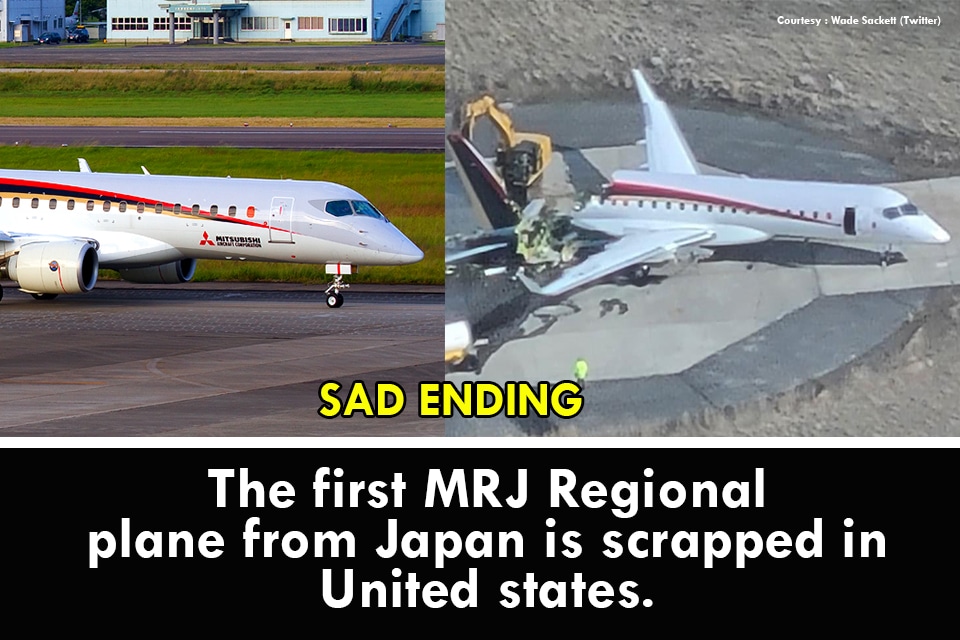Aerospace
The first MRJ Regional plane from Japan is scrapped in United states. After the programme had terminated

Japan is renowned for its technological advancement, consistently outpacing other nations. In 2003, the well-known Japanese corporation Mitsubishi plans to launch a regional jet aircraft with a seating capacity of 70 to 90 seats, just like in other nations. An indigenous regional jet for 30 to 90 people is the subject of a five-year, 50 billion ($420 million) research project that was launched by Japan.
The first Mitsubishi Aircraft Regional Jet / SpaceJet JA21MJ, which was based at Grant County International Airport in Moses Lake, is being destroyed. Due to the lack of a successful testing phase. The program is terminated. Most aviation enthusiasts disagreed with the choice to scrap items rather than donate them to the museum.
Mitsubishi Announced The Discontinuation Of SpaceJet program(Opens in a new browser tab)
Let’s find out more about this plane. Several problems have caused the project to be postponed, and MHI keeps delaying its debut. At first, it also received some orders from airlines based in Japan. such as the SpaceJet program. The planned entry was delayed because flight testing took longer than anticipated, and as a result, development was first postponed in October 2020 and then stopped completely in February 2023.
Two versions of MRJ M90 and M100.
Mitsubishi Aircraft Corporation, a division of Mitsubishi Heavy Industries, created the Mitsubishi SpaceJet family of regional jet aircraft. The Mitsubishi SpaceJet M90 and Mitsubishi SpaceJet M100 are the two current versions that make up the SpaceJet family.
Up to 90 passengers can board the regional plane Mitsubishi SpaceJet M90. It has a maximum range of 2,200 nautical miles and two Pratt & Whitney PW1217G engines. The Mitsubishi Aircraft Corporation has been working on the M90 for a number of years, with the initial goal of delivering the first aircraft to launch client ANA in 2020. The delivery has been delayed, nevertheless, because of a number of problems.
The Mitsubishi SpaceJet program has had numerous difficulties and failures, which has caused some business analysts to view the initiative as a failure. The following are some of the main problems that have added to the SpaceJet program’s difficulties:
1. Delays in development: The SpaceJet program has faced major setbacks, with the initial delivery to launch customer ANA being repeatedly postponed. Several technical problems and design modifications contributed to the delays, which in turn led to more expenses and additional delays.
2. Few consumers have placed orders for the SpaceJet program, which has had difficulty getting orders from airlines. Instead, many airlines have opted to buy regional planes from different producers like Embraer and Bombardier.
3. Effect of COVID-19 pandemic: Due to the need for airlines to reduce fleet size and postpone new aircraft deliveries, the COVID-19 pandemic has had a negative influence on the SpaceJet program. This has made it even harder for Mitsubishi to acquire additional SpaceJet orders.
4. yet another delay In 2018, Bombardier filed a lawsuit against MRJ for allegedly stealing the trade-secret blueprints for its aircraft. MRJ was granted relief from the allegation by federal judges. It has accomplished about 2600 flying hours up to that point. Yet later, when the aircraft was being tested, there was yet another delay. in 2019,
5. Financial setbacks: Despite Mitsubishi Heavy Industries investing billions of dollars in the SpaceJet program, there have been financial difficulties. But because of the holdups and a lack of orders, the program hasn’t brought in enough money to pay for its development expenses.
The corporation was looking for a reliable source of funding to support the manufacture of airplanes. The flying display was performed by the aircraft in 2018 at the Farnborough air show. Due to the delays, the aircraft is also receiving some criticism. For all of the prototypes that were improved gradually, it has finished roughly 9 aircraft. MHI persisted in working on this project. More than a billion dollars were invested. but even so, the airworthiness authorities were never impressed.
6. More than 900 design changes have reportedly been made, many of which necessitate going back to the basic design stage. Examples of these changes include a review of the design load and adjustments to the system design of various systems. During the testing phase, numerous design modifications were made to the wings, landing gear, fuselage, wiring, and avionics. Throughout the testing stage, numerous design modifications were done.
The SpaceJet program has generally encountered a number of challenges that have made it challenging for it to prosper, raising questions about its future and whether it will ever enter service. The development of the SpaceJet M100 has been put on hold as Mitsubishi Aircraft Company reevaluates its approach to the SpaceJet program.
Following five revisions of the planning delay, it was stated in October 2020 that the project would be frozen. Five prototypes have already made the trip to the US for flight testing, however, testing has been halted and one of them has had its aircraft registration canceled. The process for acquiring this kind of accreditation was the main cause of delays in the MRJ project. A significant design change was made in order to get type certification, which also contributed to the significant fifth delay, which dealt the business freeze its fatal blow.
Engine maintenance is now being performed on a variety of aircraft at the facility that was constructed for the production of MRJ aircraft. This will be capable of producing 15 units per month.

Aerospace
India is set to build a central command for the Air Traffic Control system, called ISHAN

India’s air traffic growth has led to increased responsibilities for air traffic control. The Airports Authority of India (AAI) is considering centralizing air traffic control for aircraft, dividing the country into four regions. The goal is to consolidate India’s segmented airspace into a single entity to improve air traffic management (ATM) efficiency, safety, and smoothness.
Recently, the AAI invited expressions of interest to develop a detailed project report for the Indian Single Sky Harmonized Air Traffic Management (ISHAN) initiative in Nagpur. Under this plan, air traffic controllers in Nagpur would handle domestic flights flying above 25,000 feet, eliminating the need for coordination among controllers in different regions.
For domestic regional flights operating above 25,000 feet, control would shift to the central command in Nagpur. This consolidation aims to enhance airline operations, increase flight handling capacity, and reduce congestion and flight times for passengers.
Currently, the AAI provides ATM services over Indian airspace and adjoining oceanic areas, covering over 2.8 million square nautical miles. This airspace is divided into four flight information regions (FIRs) in Delhi, Mumbai, Kolkata, and Chennai, along with a sub-FIR in Guwahati.
FIRs are responsible for providing air traffic services, including weather information, visibility, and search and rescue assistance. The proposed unification under the ISHAN initiative aligns with the projected growth of the aviation industry, which anticipates a doubling of domestic passenger traffic by 2030.
Aerospace
Does AirAsia show interest in Comac aircraft in the future?

Tony Fernandes, CEO of Capital A, operating as AirAsia Group, recently paid a visit to the facilities of COMAC on April 2, 2024, and was thoroughly impressed by what he witnessed.
C919 already securing nearly 1000 orders
COMAC, known for its homegrown aircraft, has launched two promising jets: the ARJ21 and the C919 aircraft. Both aircraft are gaining popularity in the Chinese market, with the C919 already securing nearly 1000 orders from various airlines.
Fernandes expressed his admiration for COMAC’s achievements in aircraft manufacturing, acknowledging the immense challenge it entails. His visit underscored the realization that AirAsia now has a viable third option when it comes to selecting aircraft for its fleet.
During his tour, Fernandes was delighted by the innovation and technology evident in COMAC’s aircraft production and the company’s commitment to long-term partnerships.
He noted that many Western companies have shifted away from prioritizing loyalty and customer service, opting instead for short-term gains and a narrow definition of success.
Last month, COMAC embarked on an international tour, showcasing demonstration flights to neighboring countries, particularly Indonesia and Malaysia. Fernandes believes that the positive impression left by COMAC during his visit opens up new opportunities for collaboration.
Fernandes emphasized COMAC’s remarkable achievements
The shared values of loyalty, customer service, and long-term vision align closely with AirAsia’s ethos, making collaboration with COMAC appealing. With a focus on innovation and excellence, both companies stand to benefit from a partnership grounded in trust and a shared commitment to success.
Indonesia and China have already collaborated in validating and maintaining the airworthiness of the ARJ21 aircraft, indicating a solid foundation for future partnerships.
In his statement, Fernandes emphasized COMAC’s remarkable achievements and genuine desire for long-term partnership, highlighting the absence of ego and a genuine willingness to succeed together. He marveled at COMAC’s fully automated, AI-driven factory, a testament to their dedication to innovation and efficiency.
Fernandes criticized Western firms for prioritizing short-term gains over loyalty, customer service, and long-term strategy, emphasizing the importance of understanding customers’ needs and collaborating to achieve success.
Aerospace
Indigo will soon launch Air Taxi Service in India

InterGlobe Enterprises, the parent brand of IndiGo, is set to revolutionize travel in India with its upcoming air taxi service.
Scheduled for a potential launch in 2026, this innovative venture promises a seamless journey for passengers between two bustling hubs. Delhi and Gurgaon in Haryana. The forthcoming service is projected to revolutionize the daily commute, offering passengers a swift aerial journey covering the distance in a mere 7 minutes.
This remarkable efficiency contrasts starkly with the conventional 90-minute drive, underscoring the immense time-saving potential for commuters. The anticipated fare, ranging from Rs 2,000-3,000, makes this innovative mode of transport not only swift but also remarkably competitive in pricing.
At the heart of this ambitious endeavor lies a strategic partnership with Archer Aviation, a pioneer in electric vertical takeoff and landing (eVTOL) aircraft technology. Under this collaboration, Archer will supply 200 state-of-the-art eVTOL aircraft, representing an investment of US$ 1 billion. These cutting-edge aircraft, capable of accommodating up to four passengers alongside the pilot, epitomize the future of sustainable air travel.
Powered by six battery packs, Archer’s eVTOL aircraft boast rapid charging capabilities, enabling a swift turnaround between flights. With a charging time of just 30-40 minutes, these eco-friendly aircraft ensure minimal downtime, maximizing operational efficiency.
Similar services are anticipated to be introduced by the joint venture in Bengaluru and Mumbai as well. Nevertheless, the service rollout period has not yet been made public by the company. Next year, it is anticipated to get its certification. Following this, the company will start the certification procedure with the Directorate General of Civil Aviation (DGCA).























